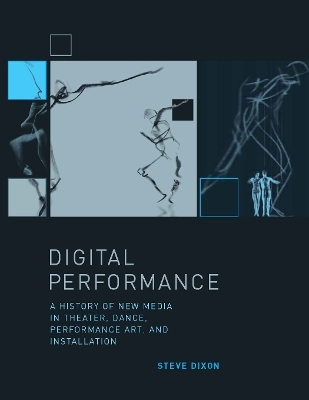
Digital Performance
A History of New Media in Theater, Dance, Performance Art, and Installation
Seiten
2007
MIT Press (Verlag)
978-0-262-04235-2 (ISBN)
MIT Press (Verlag)
978-0-262-04235-2 (ISBN)
- Keine Verlagsinformationen verfügbar
- Artikel merken
The historical roots, key practitioners, and artistic, theoretical, and technological trends in the incorporation of new media into the performing arts.
The past decade has seen an extraordinarily intense period of experimentation with computer technology within the performing arts. Digital media has been increasingly incorporated into live theater and dance, and new forms of interactive performance have emerged in participatory installations, on CD-ROM, and on the Web. In Digital Performance, Steve Dixon traces the evolution of these practices, presents detailed accounts of key practitioners and performances, and analyzes the theoretical, artistic, and technological contexts of this form of new media art. Dixon finds precursors to today's digital performances in past forms of theatrical technology that range from the deus ex machina of classical Greek drama to Wagner's Gesamtkunstwerk (concept of the total artwork), and draws parallels between contemporary work and the theories and practices of Constructivism, Dada, Surrealism, Expressionism, Futurism, and multimedia pioneers of the twentieth century.
For a theoretical perspective on digital performance, Dixon draws on the work of Philip Auslander, Walter Benjamin, Roland Barthes, Jean Baudrillard, and others. To document and analyze contemporary digital performance practice, Dixon considers changes in the representation of the body, space, and time. He considers virtual bodies, avatars, and digital doubles, as well as performances by artists including Stelarc, Robert Lepage, Merce Cunningham, Laurie Anderson, Blast Theory, and Eduardo Kac. He investigates new media's novel approaches to creating theatrical spectacle, including virtual reality and robot performance work, telematic performances in which remote locations are linked in real time, Webcams, and online drama communities, and considers the "extratemporal" illusion created by some technological theater works. Finally, he defines categories of interactivity, from navigational to participatory and collaborative. Dixon challenges dominant theoretical approaches to digital performance-including what he calls postmodernism's denial of the new-and offers a series of boldly original arguments in their place.
The past decade has seen an extraordinarily intense period of experimentation with computer technology within the performing arts. Digital media has been increasingly incorporated into live theater and dance, and new forms of interactive performance have emerged in participatory installations, on CD-ROM, and on the Web. In Digital Performance, Steve Dixon traces the evolution of these practices, presents detailed accounts of key practitioners and performances, and analyzes the theoretical, artistic, and technological contexts of this form of new media art. Dixon finds precursors to today's digital performances in past forms of theatrical technology that range from the deus ex machina of classical Greek drama to Wagner's Gesamtkunstwerk (concept of the total artwork), and draws parallels between contemporary work and the theories and practices of Constructivism, Dada, Surrealism, Expressionism, Futurism, and multimedia pioneers of the twentieth century.
For a theoretical perspective on digital performance, Dixon draws on the work of Philip Auslander, Walter Benjamin, Roland Barthes, Jean Baudrillard, and others. To document and analyze contemporary digital performance practice, Dixon considers changes in the representation of the body, space, and time. He considers virtual bodies, avatars, and digital doubles, as well as performances by artists including Stelarc, Robert Lepage, Merce Cunningham, Laurie Anderson, Blast Theory, and Eduardo Kac. He investigates new media's novel approaches to creating theatrical spectacle, including virtual reality and robot performance work, telematic performances in which remote locations are linked in real time, Webcams, and online drama communities, and considers the "extratemporal" illusion created by some technological theater works. Finally, he defines categories of interactivity, from navigational to participatory and collaborative. Dixon challenges dominant theoretical approaches to digital performance-including what he calls postmodernism's denial of the new-and offers a series of boldly original arguments in their place.
Steve Dixon is President of LASALLE College of the Arts, Singapore.
| Reihe/Serie | Leonardo |
|---|---|
| Zusatzinfo | 235 illus.; 235 Illustrations |
| Verlagsort | Cambridge, Mass. |
| Sprache | englisch |
| Maße | 178 x 229 mm |
| Gewicht | 1315 g |
| Themenwelt | Kunst / Musik / Theater ► Theater / Ballett |
| Sachbuch/Ratgeber ► Sport ► Tanzen / Tanzsport | |
| ISBN-10 | 0-262-04235-5 / 0262042355 |
| ISBN-13 | 978-0-262-04235-2 / 9780262042352 |
| Zustand | Neuware |
| Haben Sie eine Frage zum Produkt? |
Mehr entdecken
aus dem Bereich
aus dem Bereich
Das Lehrbuch für den klassischen Tanz. (Band I) Ausbildungsjahre 1 …
Buch | Hardcover (2022)
Henschel Verlag in E.A. Seemann Henschel GmbH & Co. KG
45,00 €


